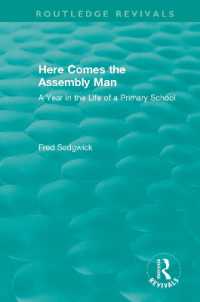- ホーム
- > 洋書
- > 英文書
- > Science / Mathematics
Full Description
Microbiologically influenced corrosion (MIC) describes the largely negative influence that a microorganism can have on a material, with sometimes severe consequences for humans, nature, and the economy. Although the problem of MIC has been known for decades, work on this topic has been fragmented and isolated; interdisciplinarity is the exception rather than the rule. This book offers a comprehensive and interdisciplinary investigation of the interaction between materials science and microbiology to find solutions to cope with adverse effects of MIC. It includes the current state of the field, advances in technologies, and guidance for the future to address remaining challenges.
• Addresses the latest findings, methodologies, standards, gaps, and potential improvements.
• Highlights current barriers that need to be overcome and offers solutions to situations not yet found in the literature.
• Explores a variety of sectors affected by MIC.
• Provides guidance on lab-to-field and field-to-lab knowledge transfer to design sustainable solutions.
Written by and aimed at an interdisciplinary audience, this work serves as an essential reference for readers across the materials, chemical, environmental, energy, and related engineering fields as well as microbiologists and biotechnologists seeking to mitigate the negative impact of MIC on industry and livelihoods.
Contents
0. Front Matter 1. A Brief History of Microbiologically Influenced Corrosion Research with Personal Reflections 2. Microbiologically Influenced Corrosion Principles and Current Perspectives 3. Integrated Analysis and Diagnosis of Corrosion Causes: A Comprehensive Approach Informed by Latest Research and Analytical Techniques 4. Feasibility and Sustainability of MIC Monitoring Methods 5. Methods in MIC Mitigation and Prevention 6. Standardization - What Is the Status of MIC, What is Missing and How Can We Improve It 7. Sector-Specific Insights into Methods for Monitoring and Management of Microbiologically Influenced Corrosion 8. A Case Study Approach - Bridging the Gap between Theory and Practice in Microbiologically Influenced Corrosion Management 9. Current Challenges and the Future of MIC Research End Matter I. Conclusion






